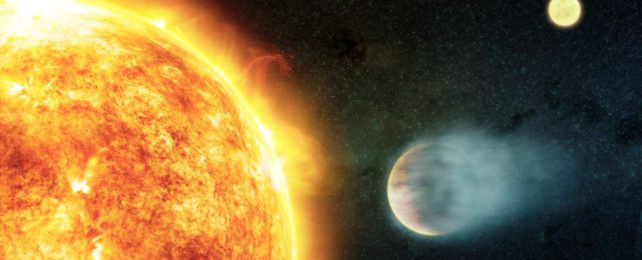Stars seem to have an anti-aging trick that humans can only dream about: their families.
Astronomers have discovered that the presence of the right-sized planet orbiting its parent fast enough seems to slow the star's aging process. Specifically, a closely orbiting gas giant can transfer angular momentum to the star's spin, countering the gradual loss of rotation resulting from the braking effect of the star's magnetic field.
The effect exoplanets have on the rotation of their host stars is a little tricky to study. If you're looking at one star and one planet, you basically have no way of knowing if the rotation speed has been influenced by the planet at all.
However, many stars in the Universe occur in multiple-star systems. Binary stars are usually stellar twins, born in the same nebula, from the same clump of dust and gas. As such, their properties are often very similar. They have a similar color, size, brightness, and, yes, rotation.
So, to make a closer examination of the influence of planets on stellar rotation and activity, a team of astronomers led by Nikoleta Ilic of the Leibniz Institute for Astrophysics Potsdam (AIP) in Germany conducted the equivalent of a twin study for stars.
They sought out binary star systems where one star has exoplanets in orbit and the doesn't. They then used the planet-less star as a control to look for changes potentially wrought by the planet orbiting the other star.
But one star system alone wouldn't be enough to establish a pattern; in their study, the team closely examined 34 binaries.
"In medicine, you need a lot of patients enrolled in a study to know if the effects are real or some sort of outlier," Ilic says. "The same can be true in astronomy, and this study gives us the confidence that these hot Jupiters are really making the stars they orbit act younger than they are."
Hot Jupiters are oddballs. They're gas giants, like Jupiter, but they hang out incredibly close to their host stars – with orbital periods of days or even hours. At that proximity they are superheated by the star, earning them their title.
Ilic and her colleagues studied X-ray data on their 34 binary systems, obtained by NASA's Chandra observatory. Because stars that spin faster exhibit more X-ray activity than stars that spin more slowly, they were able to find a distinct rotation rate difference between the two stars in their binary pairs.
Sure enough, the faster stars were those with hot Jupiters; giants that orbited a greater distance from their star had no observable effect. That rules out our own Sun (sorry, Sun).
Since star rotation gradually slows over time, younger stars tend to spin faster than older stars with similar properties. This suggests that hot Jupiters are kind of like wrinkle cream for stars. The interaction between the star and the exoplanet results in a transfer of spin from the exoplanet to the star that boosts the spin of the latter.
The finer details of this interaction are currently something of a mystery. For the sake of their analysis, the researchers assumed that it was tidal based on the gravitational attraction between the two bodies. But magnetic forces could play a role. Further investigation could help figure out the nitty-gritty specifics.
"In previous cases, there were some very intriguing hints, but now we finally have statistical evidence that some planets are indeed influencing their stars and keeping them acting young," says astronomer Marzieh Hosseini of AIP.
"Hopefully, future studies will help to uncover more systems to better understand this effect."
The research has been published in the Monthly Notices of the Royal Astronomical Society.
